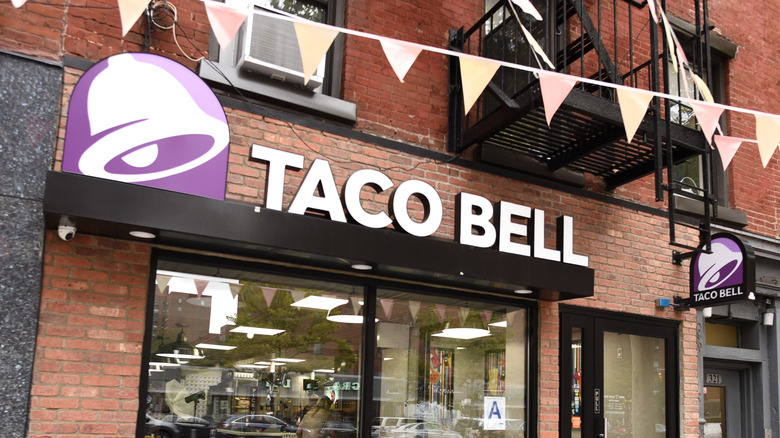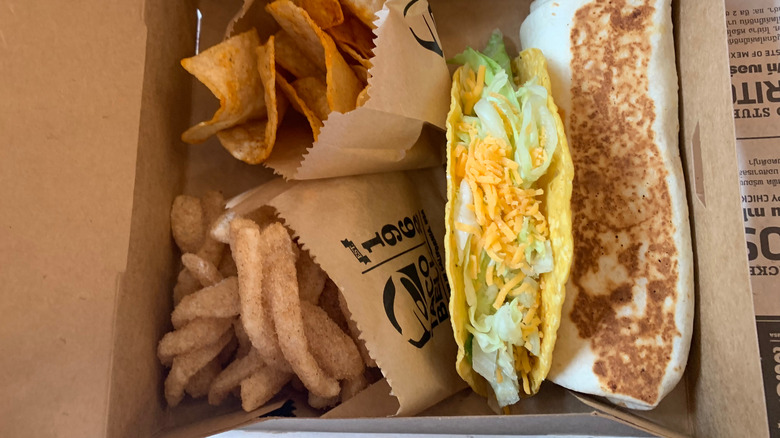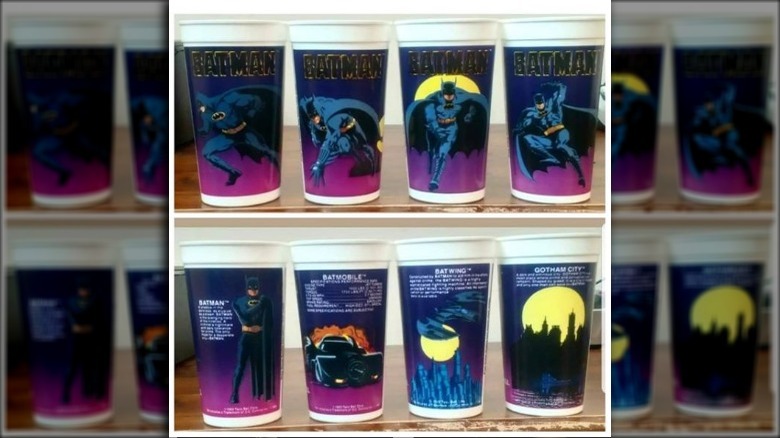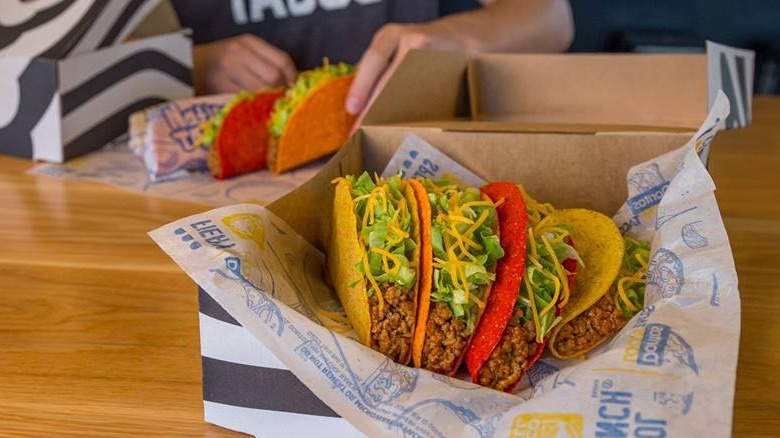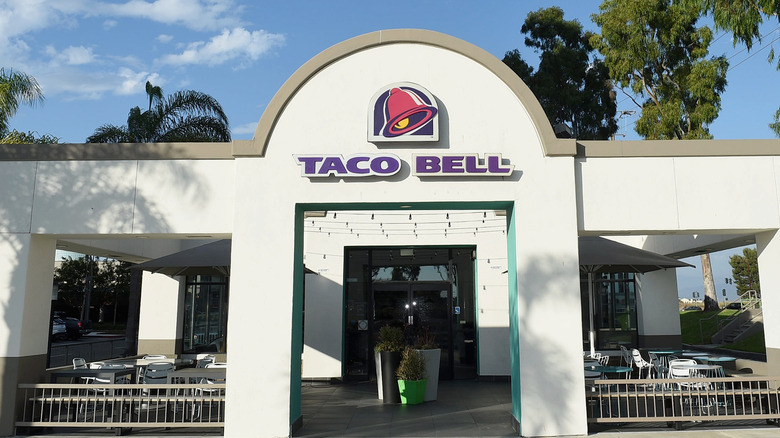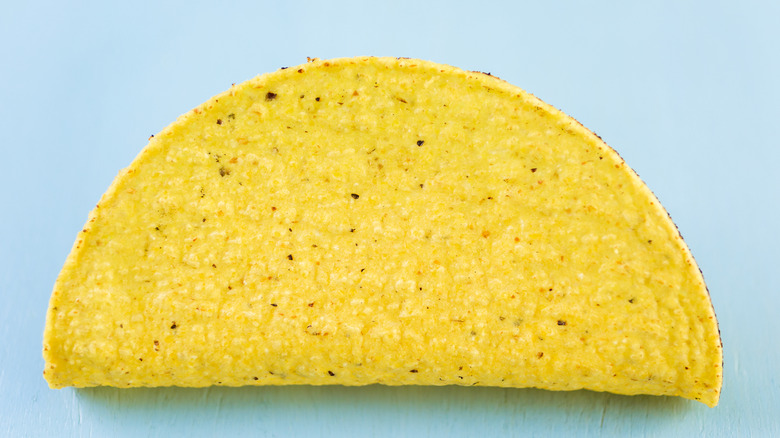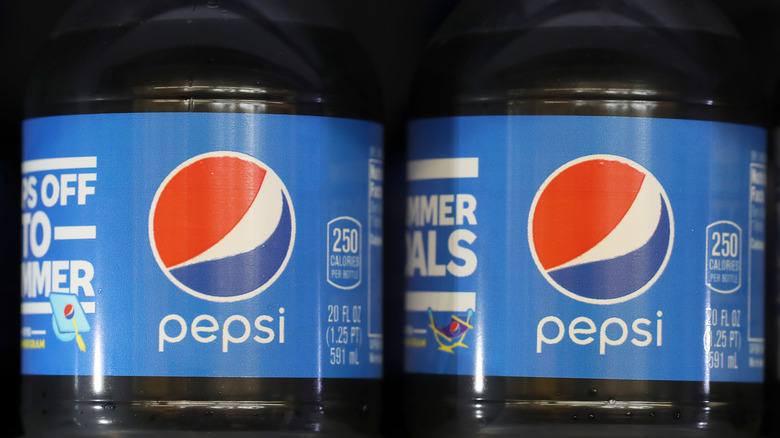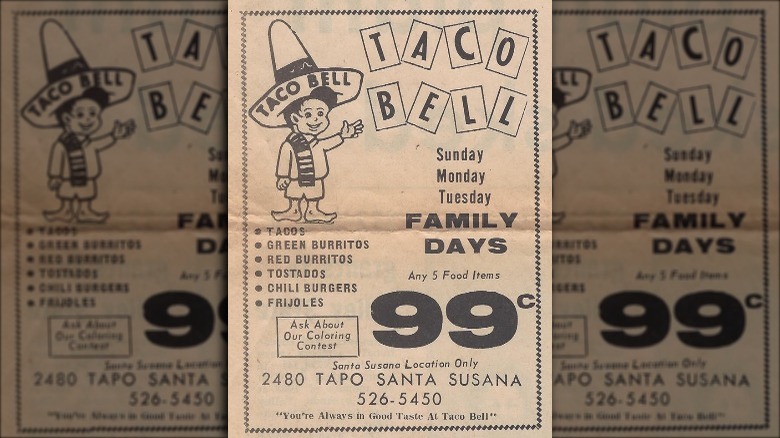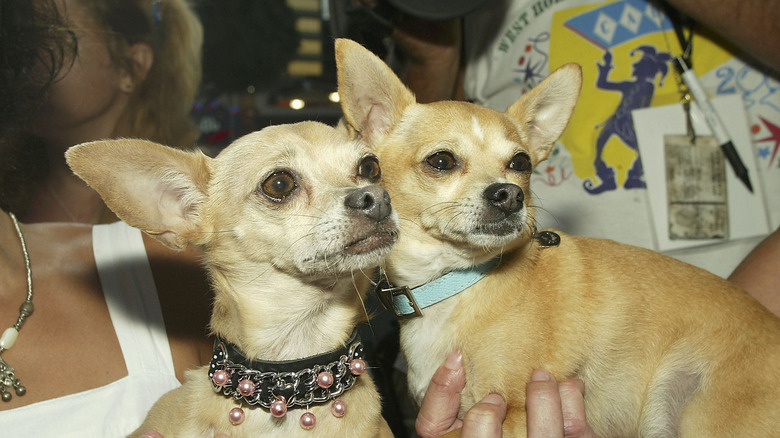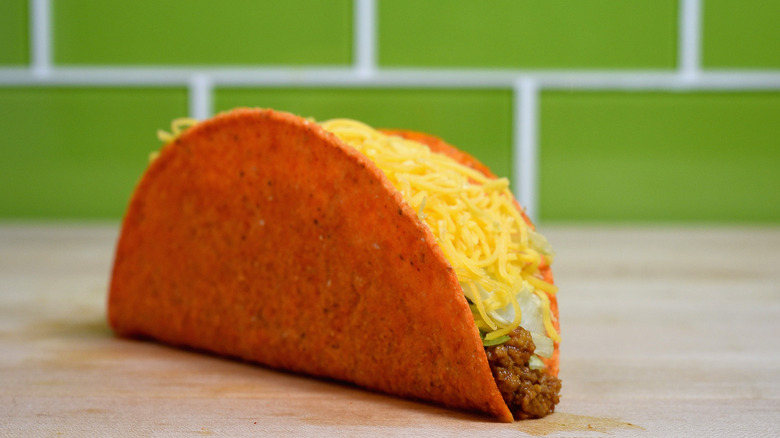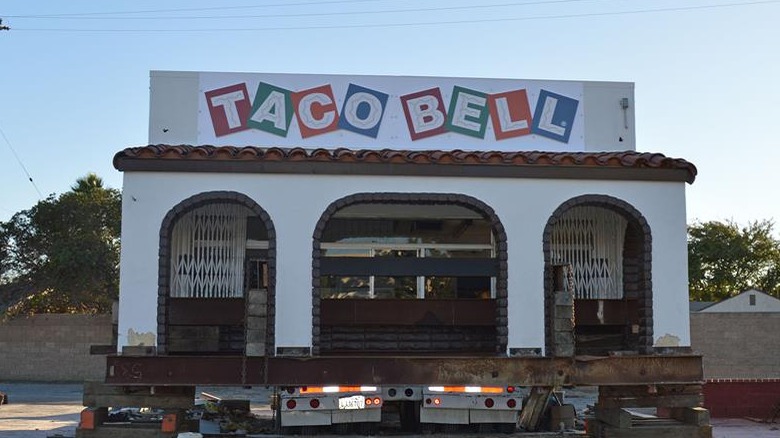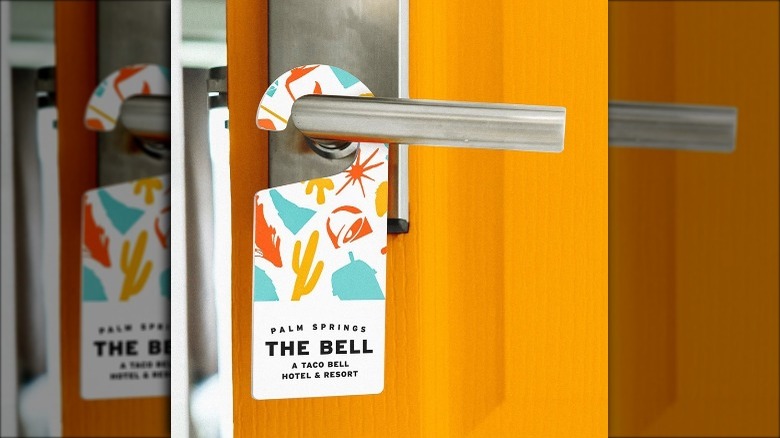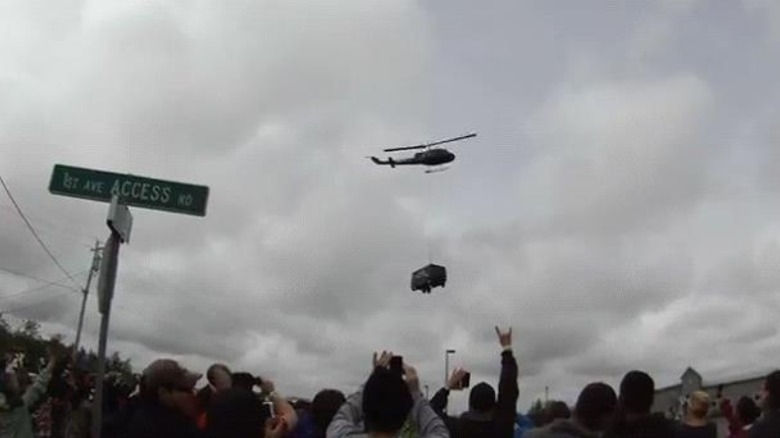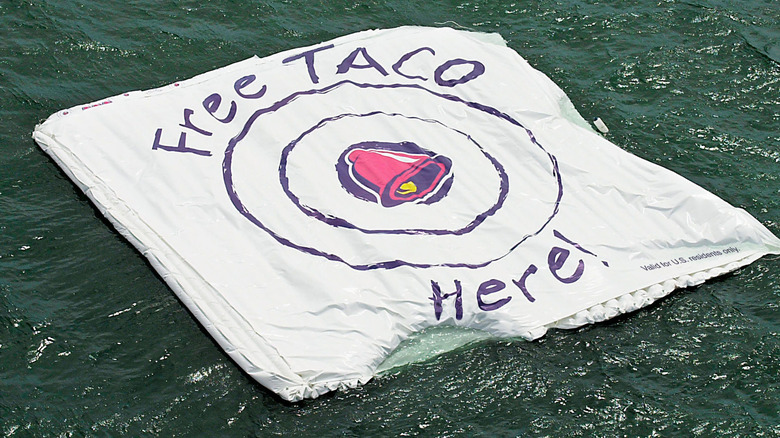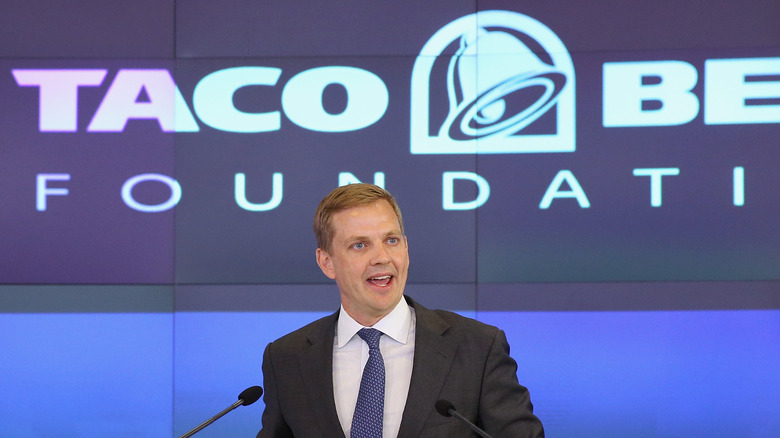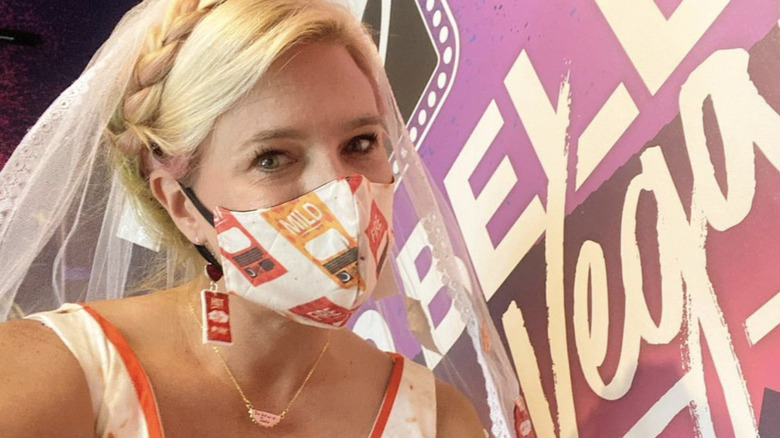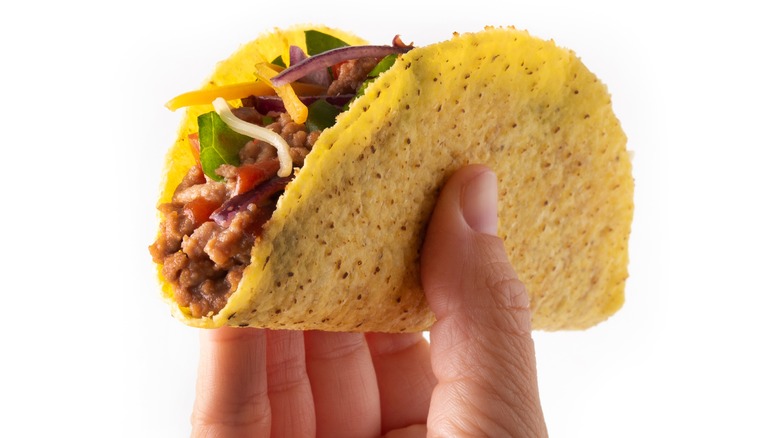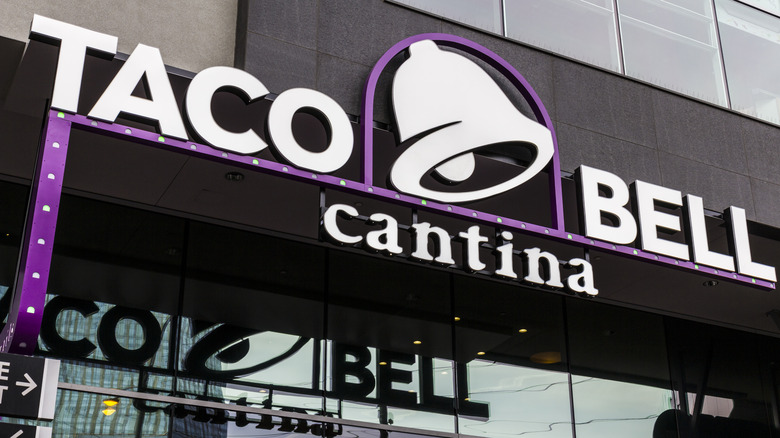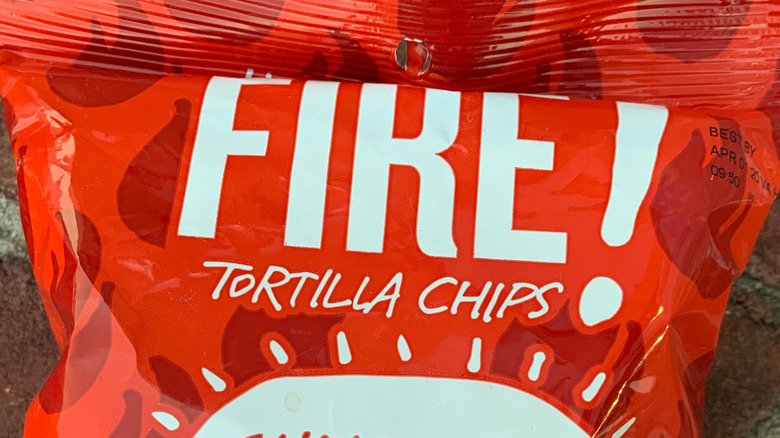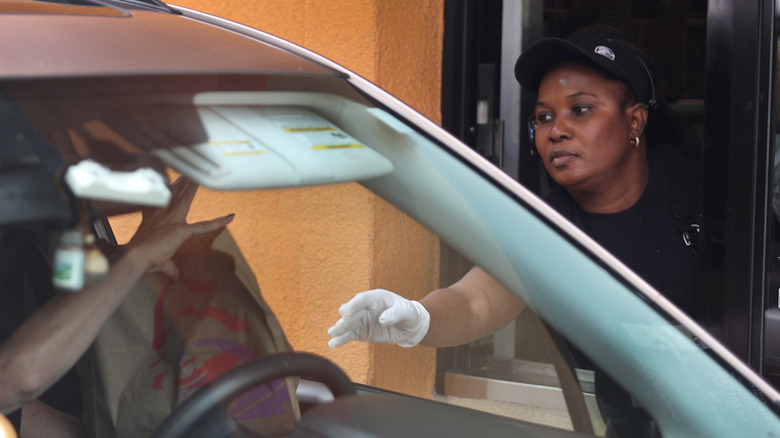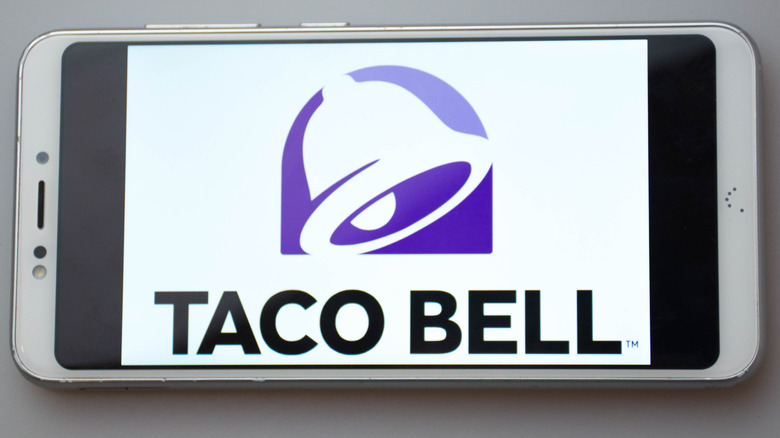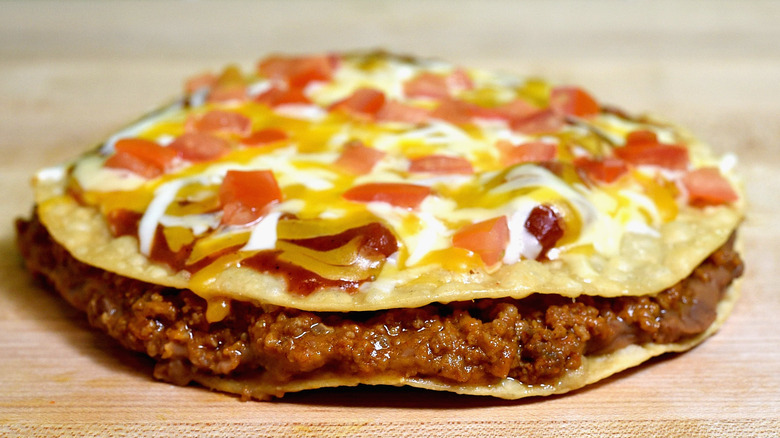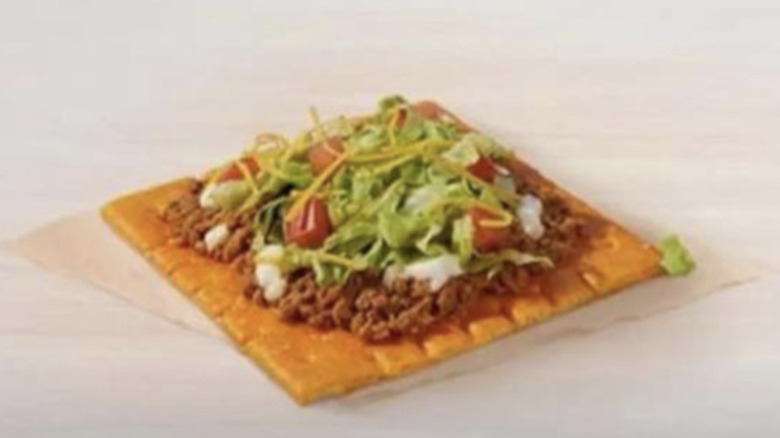The Untold Truth Of Taco Bell
We may receive a commission on purchases made from links.
If you've ever gotten a late-night craving for some crunchy tacos and a frozen Mountain Dew Baja Blast, chances are you've headed on over to your local Taco Bell. With locations in every state (one dedicated fan even road-tripped around the country to eat at a Taco Bell in each one) and almost 30 countries, the chain is pretty ubiquitous.
Sure, the menu has gone through some changes over the years. The original restaurant served up crunchy tacos (which the Anglo customers apparently called Tay-Kohs) along with something called the chiliburger, but the restaurant's offerings evolved over the years to include beloved discontinued Taco Bell menu items like the Enchirito, Extreme Nachos, and the probably best forgotten Seafood Salad.
Even if you've mastered the art of the copycat Crunchwrap Supreme recipe and your glove compartment is overflowing with expired packets of Fire Sauce that you refuse to let go of, there's still a lot you may not know about Taco Bell. From the story of how they invented their now-famous Doritos Locos Tacos to a few of their zaniest promotions, these weird facts about Taco Bell might just end up making you hungry enough to hit the drive-thru.
Taco Bell has some of the best vegetarian fast food options around
Taco Bell may be known for its meaty items like the Chipotle Chicken Loaded Griller and budget-friendly Beefy Fritos Burrito, but like a lot of other fast food restaurants, it's making expanding their vegan and vegetarian options a priority.
While Taco Bell has always been a good option for those who eat meat-free (you can sub any of the meat products in their menu items for beans, rice, or potatoes, all of which are vegan, and their guacamole can be subbed for sour cream), in 2019 it made a corporate commitment to making their menu even more friendly to vegetarians and vegans.
There are already 8 million vegetarian combinations diners can choose from at Taco Bell, and the chain is also testing their first official vegetarian menu. They even have a guide to eating vegan at Taco Bell on their website that was created in partnership with the American Vegetarian Association, which shows diners how to make some of their most classic menu items, like the Crunchwrap Supreme and soft taco, both meat and dairy free.
The chain is also testing some new vegetarian items for 2019, so meat-free diners should keep their eyes peeled for these menu additions.
Taco Bell's Batman movie promo in 1989 changed fast food advertising
In 1989, Taco Bell did something that not a lot of its peers were experimenting with at the time. They teamed up with the Tim Burton-directed "Batman" movie premiering that year for an advertising campaign that wound up being a huge success.
Taco Bell ran a promotion all summer involving Batman Collector Cups, and it ended up breaking records for the chain's promotional-tie ins. Customers who ordered a large drink would get one of the collectible plastic Batman cups, and Taco Bell restaurants were decorated with massive cardboard cutouts of Batman to drum up excitement.
One store reported that their sales went up 25% thanks to the promotion, and sales of large drinks at one location went from 600 to 1,000 a day.
Not only did the campaign boost sales at Taco Bell, but it also inspired Batman enthusiasts to actually steal the cardboard cutouts that were on display at the restaurants, leading one company spokesperson to say that Batman himself might actually be needed to come help save his cardboard cutouts from being stolen.
According to Digital Spy, this was one of the first times a movie was advertised across so many platforms that it became a product in itself — but it certainly wasn't the last time.
Their beef isn't 100 percent beef... and it comes in a bag
There have been a lot of rumors about Taco Bell's beef over the years, with skeptics claiming that it was made with everything from mealworms to Grade D beef — which, spoiler alert, doesn't even exist.
While Taco Bell's beef does come pre-cooked and in bags, the rest of the truth is a lot less scandalous than claims that the chain's meat is only 36% beef.
It's actually 88% beef, and the other ingredients rounding out the recipe are pretty common.
Yes, they do use some fillers derived from oats, and the meat is blended with soy lecithin, which is used to make sure the ingredients in their beef don't separate, but overall the ingredient list isn't anything more shocking than what you'd find at any fast food restaurant.
These days the chain is doing even more to make sure their beef is up to standard. Taco Bell is focusing on sourcing more of their beef from sustainable suppliers, and they're also prioritizing suppliers that are reducing the use of antibiotics with their cattle. Who knows, maybe they'll keep inching closer to having meat that's 100% ... well, meat.
Taco Bell tried (and failed) to be successful in Mexico
As anyone who has had a taco in Mexico could probably tell you, Taco Bell's signature menu item, a ground beef taco in a crunchy pre-formed shell, is as American as can be. The chain was started in California, after all. Nevertheless, Taco Bell has tried several times to branch out into Mexico ... and failed.
Taco Bell, which serves over 2 billion customers a year, hasn't been able to make it in Mexico, even though they've made multiple attempts. The chain first attempted to make its way into the Mexican food scene when it opened a taco cart and several Taco Bells next to existing KFC restaurants in Mexico City in 1992. There was confusion from the get-go, as Mexican customers didn't know what to expect from the menu — Taco Bell's signature crispy "tacos" were more similar to tostadas than a Mexican taco, for one. Within two years, Taco Bell had closed all of its locations in Mexico.
In 2007, the chain tried again. They opened a location in a shopping mall parking lot next to a Dairy Queen in Monterrey, and tried to focus on its reputation as an American fast-food chain, rather than as a Mexican food chain. They served french fries and soft serve ice cream along with the classic Taco Bell menu offerings, but even that wasn't enough to convince Mexican consumers that the chain was a good fit, and by 2010 Taco Bell once again closed up shop in the country.
The founder of Taco Bell invented pre-formed crunchy taco shells
If you grew up thinking that all tacos came in a crunchy yellow shell and could be made effortlessly from a boxed kit of Old El Paso, you're not alone. But that version of the taco is a relatively new arrival on the scene — in fact, the crunchy pre-formed taco shell was actually invented by Taco Bell founder Glen Bell in the early '60s.
Bell was trying to figure out the best way to sell large amounts of tacos quickly, and that's when he came up with the pre-formed crunchy taco shell. Unlike tacos dorados, a type of pan-fried crispy taco, these pre-formed crispy taco shells could be made ahead of time and kept at room temperature until needed.
This was essential, because Bell was trying to compete with McDonald's, another booming chain that was taking off in San Bernardino, California. Pre-formed taco shells made it so employees didn't have to cook every single taco to order — they could just stuff the shell and sell, helping to boost their output and keep up with their hungry customers' demands.
Pepsi bought Taco Bell in 1978
Taco Bell is currently owned by Yum! Brands, which also owns KFC, Pizza Hut, and several other chains (which explains why you'll sometimes see a combo KFC/Taco Bell or Taco Bell/Pizza Hut). But it wasn't always so. While Taco Bell started off as an independent chain of franchises, in 1978 PepsiCo bought Taco Bell from company founder Glen Bell for $125 million.
Apparently, PepsiCo had been interested in Taco Bell since the early '60s after seeing how successful it had become. They even went so far as to buy a midwestern franchise called Taco Boy that they rebranded as Taco Kid, operated under the Pizza Hut brand, hoping it could be a competitor. When Taco Kid failed to thrive under PepsiCo's ownership, they decided to just buy Taco Bell instead.
Eventually, PepsiCo spun off their restaurant properties into a separate entity, Tricon Global Restaurants, which is now Yum! Brands. But PepsiCo and Taco Bell still work together. Taco Bell serves PepsiCo brand soft drinks to this day, and PepsiCo is the owner of Frito-Lay, the maker of Doritos and Fritos, both of which are included in certain Taco Bell menu items (like the Doritos Locos Tacos and the Beefy Fritos Burrito).
Taco Bell originally sold hot dogs and hamburgers
Glen Bell's first restaurant didn't sell tacos at all — it sold hot dogs and hamburgers. This was at Bell's Drive-In, which was Bell's first restaurant, incidentally operating out of San Bernardino, which is also the birthplace of McDonald's.
Glenn eventually expanded his business, opening Taco Tia, where he sold hot dogs, hamburgers, and tacos (his chili dog recipe was the inspiration for Taco Bell's original taco sauce). He originally decided to open his restaurant in a Mexican neighborhood so that if sales of tacos took off, his competitors would write it off as being a regional success, rather than one that could be replicated elsewhere. Eventually Bell realized that tacos were the key to the success of his business and should be his focus, especially after he invented pre-formed taco shells and figured out how to quickly serve tacos to the masses instead of cooking tacos to order. He opened a restaurant called El Taco, then eventually sold his shares in that and his Taco Tia locations in order to open the first Taco Bell in 1962 in Downey, California.
At the original Taco Bell, tacos and other Mexican-American favorites were the star and were sold for just 19 cents a piece. However, the restaurant did keep serving burgers for awhile, in the form of chiliburgers, but the last burger-esque item on the menu, the Bell Beefer, was discontinued in the '90s.
The Taco Bell dog didn't make the company money
Chances are that at some point in the 1990s you saw one of Taco Bell's "Yo quiero Taco Bell!" commercials featuring a little Chihuahua named Gidget, part of a $500 million advertising campaign. Strangely enough, though the campaign was widely aired and became part of the cultural lexicon of the decade, it turns out that the expensive commercial campaign didn't actually increase sales for Taco Bell.
In fact, it cost the company money in more than one way. That's because in 2003, two men who say they created the idea of the Taco Bell dog sued the company for $42 million, and Taco Bell eventually settled the case out of court.
Gidget passed away in 2009 at the ripe old age of 15, and her trainer says that her Taco Bell gig pretty much ruined her career. "She was kind of typecast, so she never really go much work after that," said her trainer. However, though her stardom waned, Gidget was able to stay above the Taco Bell scandal. After her days as a Taco Bell darling the little pup starred in "Legally Blonde 2" as Bruiser, the dog belonging to legal wizard Elle Woods, and also had a bit part in the movie "Beverly Hills Chihuahua."
There were more than 40 test versions of Taco Bell's Doritos Locos Taco
When Taco Bell first introduced their now-famous Doritos Locos Tacos, they had no idea it would be a hit, but after selling 100 million nacho cheese Doritos Locos Tacos in the first 70 days that it was on the menu, it was clear that all of their testing and prototyping had paid off.
Making the cheesy Doritos Locos shell took a lot of hard work. 40 different versions were tested before they settled on the final product. The company wanted to make sure that the shell had the signature cheesiness of a regular Dorito chip, but the taco shell needed to maintain its original texture, as the texture of a regular Dorito is too brittle and would break when stuffed with taco ingredients.
Another hurdle to the invention was worker safety. Initially, blasting the taco shells with cheesy powder proved to be a hazard to the workers, who would inhale it, so the company had to create a totally new machine for seasoning the shells safely.
Taco Bell's hard work paid off, and with more than a billion Doritos Locos Tacos sold in the year of their introduction. There's no denying that they're now a fast food legend.
It wasn't until 2018, when the chain introduced Nacho Fries, that the Doritos Locos Tacos were dethroned as the most popular new Taco Bell menu item of all time.
The original Taco Bell was moved to company headquarters
The original Taco Bell restaurant opened up in 1962 in Downey, California, but "Taco Bell Numero Uno," as the company calls it, ceased to operate as a Taco Bell in 1986.
However, even though the building was no longer an official Taco Bell restaurant, it was rented out to other taquerias over the years until 2014, when it was abandoned for good... that is, until Taco Bell decided that they couldn't let this piece of their history get torn down.
Instead, they decided to lift the building off its foundation and transport it to the current-day company headquarters in Irvine, California, 45 miles away. The journey took place on November 19, 2015, and luckily the petite 400-square-foot building made it safely through the streets of Los Angeles to its new home. The journey was even documented on video so superfans of the chain could watch its migration.
The chain hasn't said what plans, if any, they have for Taco Bell Numero Uno now that it's safely settled in at its new location, but at the very least they've preserved an important piece of the company's history.
There's a Taco Bell hotel
You've heard of a bed & breakfast, so why not have a Taco Bell Hotel? Apparently the chain thought the idea wasn't too crazy to try out, and in August of 2019, they opened up The Bell: A Taco Bell Hotel and Resort in Palm Springs, California, for the weekend of August 8-12 only.
Guests age 18 and over who successfully nabbed a room got to enjoy a Taco Bell-themed room, and the hotel itself (which usually operates as the V Palm Springs Resort) was decked out with Taco Bell memorabilia, a Taco Bell gift shop, a Taco Bell nail salon, and got to enjoy a "happier hour" that included Taco Bell snacks and cocktails for those 21 and older. There was also a Mountain Dew Baja Blast "Freeze Lounge" to hang out in, "dive-in" movies in the pool, and Taco Bell on call when ordering room service.
There were only 70 rooms available at the resort, and when Taco Bell opened up their reservations, they booked fast — in fact, every room was reserved within two minutes. Basically, in the time it takes the average person to wolf down a Crunchwrap, the rooms were already sold. Here's hoping this is one weird stunt they revisit — every Taco Bell fan deserves a chance to stay at The Bell.
Taco Bell delivered 10,000 tacos to Alaska via helicopter
There may be 15 Taco Bell restaurants in Alaska, but it's a huge state, so if you don't live nearby one of them, good luck getting your Chalupa on when the craving strikes. That's why it was so tragic when residents of Bethel, Alaska fell for a hoax that claimed the small town of less than 7,000 people was finally getting its own Taco Bell, something to celebrate when the nearest Taco Bell is 400 miles away from home. However, it turned out to be a hoax. Someone had put up flyers around the town advertising the restaurant opening, and when residents realized it wasn't so, they were devastated.
Taco Bell to the rescue. When they heard about the prank, they decided to take action. "If we can feed people in Afghanistan and Iraq, we can feed people in Bethel," the company CEO waxed poetically. While the chain didn't actually set up shop in Bethel, they did the next best thing — helicoptered in a delivery of hundreds of pounds of food, enough for the town to come together and cook up 10,000 Doritos Locos Tacos. Video shows a delivery truck loaded with ingredients being lowered safely to the ground by helicopter, and though there's no footage of what happened next, we can only assume the people of Bethel feasted like they'd never feasted before.
Taco Bell was ready to offer free tacos if a falling space station hit a target
In 2001, the Russian space program made the world aware that 20 tons of mass from its Mir space station orbiting the planet was due to fall to Earth. According to the BBC, the plummeting mass looked to hit in an area in the southern Pacific Ocean in a 200-mile-by-3,700-mile targeted location, at about 2:30 p.m., Eastern standard time, on March 23, 2001.
As a quirky publicity stunt to keep the attention on itself as millions of eyes potentially fixated on the sky on that date, Taco Bell announced that if the core of the falling Mir struck a floating target it had built in the sea, every American would receive a free regular taco. It was highly unlikely that Mir would land on the Taco Bell target, a 40-foot-by-40-foot vinyl sheet adorned with the company's logo and the words "Free Taco Here!" Nevertheless, in case it did have to deliver on the free tacos, Taco Bell took out an insurance policy in the amount of $10 million, the cost of handing out about $280 million in free merchandise, according to Chief Marketer. When Mir did fall, it didn't hit anywhere near the Taco Bell target, anchored 10 miles off Australia, but much closer to Chile. Taco Bell instead offered a consolation prize of two tacos for 99 cents.
It's made some charitable donations over the years
Taco Bell funnels a lot of the fortune it generates selling affordable fast food into various charitable causes and nonprofit organizations. The company oversees the Taco Bell Foundation, which specializes in allocating money to educational organizations and providing opportunities to young people in underserved communities, collecting donations from the parent corporation as well as vendors, franchise operators, and customers. Among the foundation's primary activities is the Live Más Scholarship, which has delivered $8 million in scholarship money to deserving students across the U.S., particularly those who balanced their studies with jobs at Taco Bell.
According to Taco Bell, it created the TEENsupreme program in 1992, a collaborative effort with the Boys and Girls Clubs of America. Within 10 years, more than $10 million had been raised by the Taco Bell Foundation, and that money directly went to help 500,000 teenagers enrolled in TEENsupreme.
You can get married at the Taco Bell wedding chapel in Las Vegas
Some people get married in a church, others get hitched in a beautiful and idyllic outdoor setting — and a relatively small handful of people choose to pledge to love and honor one another 'till death do them part in the friendly and comfortable environs of a Taco Bell. The restaurant chain's upscale flagship Cantina offshoot location in Las Vegas can be booked for weddings. Taco Bell even offers a Wedding Package, a prearranged deal that takes care of virtually every element of a couple's special day. Both spouses-to-be receive custom-made Taco Bell "Wedding Swag," including a garter and bow tie made out of sauce packet fabric, matching "Just Married" T-shirts, champagne glasses, a multiple-taco Party Pack, and a wedding cake made out of the chain's Cinnabon Delights dessert.
Potential newlyweds can book the Taco Bell chapel in as little as four hours notice, and the price includes a half-hour ceremony with an officiant, as well as a reception area for up to 25 guests. For an additional fee, anyone walking down the aisle can purchase an optional wedding bouquet made from Taco Bell sauce packets. The complete Wedding Package costs $750.
Without the Mitla Café, there'd be no Taco Bell
The signature, most famous offering at Taco Bell is the hard-shell taco, a crispy, fried corn tortilla filled with seasoned beef, cheddar cheese, and lettuce. That same item and variations of it are found at restaurants across the U.S., because it was popularized by Taco Bell. After starting Bell's Drive-In and Taco Tia in San Bernardino in the 1950s, Glen Bell opened the first Taco Bell in Downey, California, in 1962.
According to BBC Travel, the idea for the hard-shell taco wasn't Bell's. Lucia Rodriguez emigrated from Jalisco, Mexico to San Bernardino, and opened a small restaurant called the Mitla Café in 1937. Having grown up eating hard-shell tacos filled with mashed potatoes, Rodriguez adapted the item for the Mitla Café, replacing the spuds with beef, cheese, lettuce, and tomatoes. On the strength of the tacos, the restaurant became very popular, all of which was noticed by Bell, who opened a hot dog stand across the street from the Mitla Café in 1948. When he started selling Mexican food, he took the idea of the taco from the Rodriguezes.
The Mitla Café is still around as of this writing. The Rodriguezes' daughter-in-law, Irene Montaño still worked there when writer Gustavo Arellano visited to do research for his 2013 book, as she had when Bell came sniffing around. "I remember him," she said, as Bell "used to come in late at night, ask lots of questions about how we made tacos, and then leave" (via BBC Travel).
Want something different? Try Taco Bell Cantina or Taco Bell VR Arcade
According to Statista, nearly 7,800 Taco Bells are up and running worldwide as of 2021. Most are virtual clones of one another, with the same layout and menu, but they're not all identical. According to CNBC, parent company Yum! Brands started opening a series of high-end restaurants around the U.S., called Taco Bell Cantinas. The idea was to appeal to expand Taco Bell's reach from a customer base looking for bargains into the higher-priced, slightly more upmarket restaurant segment of fast-casual establishments (such as Chipotle), as well as areas where real estate costs more. By 2020, more than 30 Taco Bell Cantinas were up and running in the U.S., including one in Las Vegas, the busiest Taco Bell of any kind in the world. Presented like trendy, chef-driven restaurants, the Cantinas employ an open kitchen and ordering kiosks, and even serve alcohol alongside tacos, burritos, and quesadillas.
In 2016, Taco Bell tested out another outgrowth in the form of the Taco Bell VR Arcade. According to AdWeek, the company created a pop-up Taco Bell and virtual reality video game arcade in New York, where curious customers could play high-tech, futuristic, and immersive games while snacking on the familiar fare of Mexican-inspired fast food.
You can grab Taco Bell products at the grocery store
According to Convenience Store News, Taco Bell's Doritos Locos Tacos was the chain's most successful new product in company history when it launched in 2012. After it profitably turned items commonly available at grocery stores — snack chips — into restaurant menu items, the company adapted the other way, launching a line of packaged foods based on menu highlights, allowing Taco Bell fans to recreate those tastes at home.
Adding to a well-established line of taco meal kits, canned beans, and taco shells made by Kraft and sold in food stores, according to USA Today, Taco Bell started selling its popular condiments and sauces by the bottle. Previously only available in tiny packets alongside a Taco Bell order, according to HuffPost, the easily available and readily pourable line included Mild, Hot, and Verde varieties, with Hot already selling well in stores as a test balloon. (According to Consumerist, each bottle contained the equivalent of 35 sauce packets).
Taco Bell moved into grocery and convenience stores again in 2018, with Doritos-esque flavored tortilla chips. Available in 1-ounce, 3.5-ounce, and 30-ounce bags, the snacking chips came in three flavors: unflavored Classic, Mild-sauce inspired, and spicy Fire (per USA Today).
A partnership with Lyft did not go over well
Fast food drive-through runs and calling cars via ride-sharing service are tried-and-true late-night pastimes, and so in the summer of 2017, Taco Bell attempted a cooperative publicity campaign with Lyft. According to Fortune, Taco Bell tried to popularize a concept it called "ride-thru," in which Lyft customers could easily and cheaply add in a stop at a Taco Bell drive-through between their point of pickup and programmed destination.
According to the companies involved, customers were thrilled about getting to add a food run in their Lyft trip, but many of the actual drivers who'd have to perform the service voiced their displeasure on social media. Many Lyft drivers try to ensure as pleasant a trip as possible with spotless, odor-free cars, which requires that a lot of time and money goes into cleaning their cars. Taco Bell stops, also known as "Taco Mode," they argued, would make their cars more susceptible to spilled food and drinks and tough-to-eliminate smells. It also stood to lose drivers money. Stopping at Taco Bell, and then waiting in a potentially crowded late-night drive-through lineup, used up time that drivers could otherwise use for seeking out other fares.
In response to the negative response, Taco Bell announced that Taco Mode would be optional on a driver-by-driver basis, and that it would only be test-marketed in Orange County, California.
Love tacos? You can get a taco subscription from Taco Bell
The entry-level Taco Bell taco — a tortilla or crispy shell filled with seasoned beef, cheese, and lettuce — is already one of the cheapest fast food items widely available. According to Gizmodo, the average cost of a taco was $1.49 in early 2022, which is when Taco Bell decided to offer the tacos (and other, similar menu items) at a steep discount. The catch: Taco Bell fans had to pay upfront to access the discount.
For just $10, customers could acquire a Taco Lover's Pass. For less than the price of a daily basic taco, consumers gained access to a secret menu inside Taco Bell's smartphone app that included one complimentary taco each day, for 30 days. Available only at specific, participating locations, the Taco Lover's Pass entitles users to a free item of their choice, such as a Crunchy Taco, Crunchy Taco Supreme, Soft Taco, Soft Taco Supreme, Spicy Potato Soft Taco, or Doritos Locos Taco (regular or supreme). Used to its full extent, a Taco Lover's Pass could save a daily Taco Bell visitor more than $30 a month.
People were not happy when Mexican Pizza was taken off the menu
In 2020, according to CNN, Taco Bell eliminated nearly 20 menu items, seeking to make restaurants run more efficiently amidst challenges created by the COVID-19 pandemic and lockdown. The most controversial discontinuation: that of the Mexican Pizza, which mimicked a personal-size version of its Italian inspiration, with tostada shells, enchilada sauce, beef, beans, tomatoes, and a cheese blend. It required a moderately sized cardboard box for packaging and transport, and as part of a pledge to be more environmentally friendly, cutting the Mexican Pizza from the menu meant Taco Bell would no longer use seven million pounds of paperboard.
Pop musician Doja Cat openly missed the Mexican Pizza, and twice tweeted at Taco Bell, imploring it to restore the menu item. Instead, Taco Bell approached Doja Cat to star in their 2022 Super Bowl commercial, and she made a TikTok video singing the praises of the Mexican Pizza. In April 2022, per Billboard, during her Coachella set, Doja Cat, acting as a brand ambassador, announced that the Mexican Pizza would return to Taco Bell. "I brought back the Mexican Pizza, by the way," she yelled, taking full credit.
The item became available once more in May 2022 nationwide according to USA Today. However, Taco Bell had to temporarily take the Mexican Pizza off its menu again. Pent-up demand for the long-unavailable item was so intense that many locations sold out of it within two weeks after the relaunch.
Taco Bell's Cheez-It Tostada sold out fast
Having already incorporated popular and distinctive snack foods like Doritos and Fritos into its menu offerings over the years, Taco Bell branched out beyond vaguely Tex-Mex-flavored chips in 2022 and brought cheese-flavored Cheez-It crackers to its restaurants. According to CNN, a single location in Irvine, California, ran a two-week test of two Cheez-It based items: the Big Cheez-It Tostada and the Big Cheez-It Crunchwrap Supreme. Both entrees were built around gigantic Cheez-Its specially made for Taco Bell — 16 times the size of the regular, bite-size Cheez-Its. The Big Cheez-It Tostada and the Big Cheez-it Crunchwrap Supreme substituted out the crispy corn tortilla that's normally used in favor of the cheese cracker. The Tostada offered the cracker topped with seasoned ground beef, cheese, lettuce, tomatoes, and sour cream, while the Crunchwrap Supreme utilized the massive cracker inside of a folded soft tortilla, surrounded by beef, cheese sauce, sour cream, and vegetables.
Launched on June 28, 2022, Taco Bell discontinued the Cheez-It-oriented items just five days later, on July 3, 2022. Demand was so high that the Irvine Taco Bell ran out of its entire supply of big Cheez-Its.
50 Cent sued Taco Bell in 2008
In 2008, Taco Bell launched a value menu called "Why Pay More?" Offerings all cost less than a dollar, and at three different price points of 79 cents, 89 cents, and 99 cents, according to Billboard. As a publicity stunt related to the "Why Pay More?" campaign, Taco Bell sent a joke letter to news media outlets, asking Curtis Jackson, aka rapper 50 Cent, requesting that he change his name from his familiar money-based moniker into something more reflective of Taco Bell's cheap menu: either 79 Cent, 89 Cent, or 99 Cent.
Taco Bell used the letter in promotions and advertising. One thing it didn't do was get the permission of the subject of the joke, 50 Cent himself. According to the musician's lawyer, Peter D. Raymond, 50 Cent didn't know about the letter or the stunt until he glimpsed a news report about it. He filed a lawsuit against Taco Bell for $4 million, alleging that the company was using his name without his consent. In response, Taco Bell's spokesperson Rob Poetsch issued a statement: "We made a good faith, charitable offer to 50 Cent to change his name to either 79, 89 or 99 Cent for one day by rapping his order at a Taco Bell, and we would have been very pleased to make the $10,000 donation to the charity of his choice," Poetsch wrote.
According to the New York Post, the suit was settled (with confidential terms) in November 2009.
